 |
||
|
||
| ||

Confrontation of NVIDIA and ATI products is already reaching its vertex. At present, the odds are in favor of NVIDIA thanks to production quantity (NVIDIA has much more partners than ATI, and among those firms are a lot of well powerful and famous companies) and a considerable potential for price cuts of NVIDIA based products. ATI cards are rather expensive today, because ATI's partners clock their chips at a rather low frequency, and, thus, RADEON 7500 turns out to be slower than the GeForce2 Ti. Moreover, RADEON 8500 based cards are not widely available. Unfortunately, ATI can't provide its partners with a sufficient number of video cards; therefore, the latter ones are currently selling only cards produced by request of ATI without developing their own design. Despite the fact that GeForce3 Ti 200 cards working at 175/200 (400) MHz lose to RADEON 8500LE in some tests they have a decent overclocking potential (as you remember, the GeForce3 has a greater performance gain per 1 MHz than the RADEON 8500 family) and are less dear than RADEON 8500LE cards. The price of the card's in question makes this card beyond comparison with RADEON 8500LE. However, the Canadian cards have their own advantages both in a 3D part (cheaper anisotropy) and in additional functions (dual-monitor support, advanced TV-out etc.). But their price and a great shortage of RADEON 8500 based cards make them almost noncompetitive relative to Palit Daytona GeForce3 Ti 200. Besides, in the NVIDIA GeForce3 Ti 200 camp the Palit comes out a leader! As always I should remind you that the whole theoretical base connected with the GeForce3 is concentrated in the following articles (here you can also learn the peculiarities of certain cards and find out how they operate in the latest benchmark tests).
As you can see, once we already studies a card from Palit on the GeForce3. There you can also read about this firm. It works mainly on the OEM market producing a good deal of cards by request; such cards get onto a black market and then poor-quality cards sell under the guise of normal samples. It's not difficult to label such cards as if they are produced by Inno3D or Daytona. However, Palit is not stainless itself; sometimes its cards do have some bugs. Well, let's start examining the Palit Daytona GeForce3 Ti 200. It should be noted that I have two samples which differed only in a DVI connector. CardsThe Palit Daytona GeForce3 Ti 200 has an AGP x2/x4 interface, 64 MB DDR SDRAM located in 8 chips on the right side of the PCB. The photo shows a revision with a DVI.

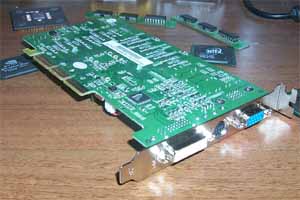

Both cards have memory modules from EtronTech with a 5 ns access time which corresponds to 200 (400) MHz. This is what NVIDIA recommends for the GeForce3 Ti 200, but heatsinks on the modules and a popular trade mark of EtronTech allow overclocking the card up to the level of GeForce3 cards (230 (460) MHz) or even higher. In the Titanium review and the following materials we showed that Ti 200/500 based cards and GeForce3 ones differ in design. Let's take a look at the design of the Palit Daytona GeForce3 Ti 200 (with DVI) and compare it with the reference one from NVIDIA: Palit Daytona GeForce3 Ti 200

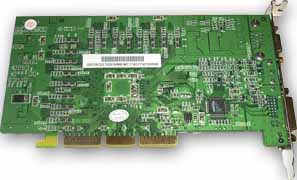
NVIDIA GeForce3 Ti 200 reference card
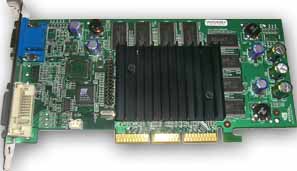
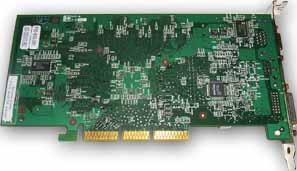
The Palit cards are not similar to the reference ones from NVIDIA. We had a lot of cards on the GeForce3 Ti 200 in our lab produced according to a new design from NVIDIA which was developed specially for this GPU. It is clear that a PCB for the Ti 200 is simpler and meant for lower frequencies of the memory than a PCB for Ti 500 or GeForce3. That is why even a very efficient memory won't score high results on this PCB, by overclocking we can reach a maximum of 240 (480) MHz. The Palit Daytona GeForce3 Ti 200 uses a different design, and probably overclocking will bear more fruit. But at the same time we shouldn't ignore 2D quality. The PCB is bright green. Heatsinks and a central cooler are standard.
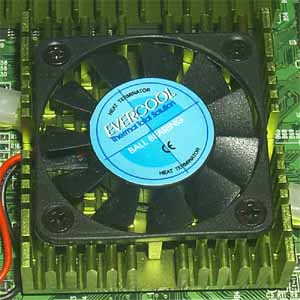
The cooler can be easily taken off; it unveils the GPU GeForce3 Ti 200 with a new marking:
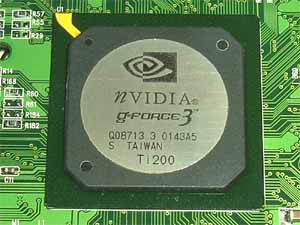
The fan is quite efficient, but if you are going to overclock the chip, you should fetch a more powerful cooler or provide additional cooling:

As I already mentioned, there are two revisions of the card: with DVI and without. As for the rest, the cards are identical. Both Palit Daytona GeForce3 Ti 200 cards are also equipped with a TV-out and an S-Video connector, but an S-Video-to-RCA adapter is not provided.
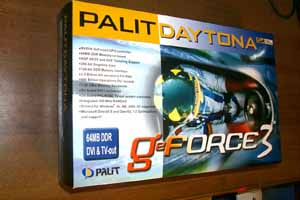
The cards ship both in a Retail package and in an OEM one; the box the card ships in is from the old GeForce3 card (beware, there are no stickers indicating that inside there is Ti 200, not a previous GeForce3!) Accessories:
OverclockingThe Palit Daytona GeForce3 Ti 200 (DVI) has a decent overclocking potential - 200/250 (500) MHz. At least, it has surpassed the GeForce3 level (a 5ns memory on the card of the standard design wouldn't reach more than 240 (480) MHz). The revision with the DVI showed record results " 230/255 (510) MHz! It has almost caught up with a more expensive Ti 500 card. Note:
Test system and driversTest system:
In the tests we used NVIDIA drivers of v.21.85. VSync was off, S3TC was on. For the comparative analyses we used the following cards:
Test results2D quality of both cards is very good. The image was excellent even in 1600x1200 at 85 Hz. Further in the 3D tests I will use a card with a greater overclocking potential, i.e. without DVI. For estimation of 3D quality we used:
Quake3 ArenaQuaver, High Quality ModesThe test was carried out in 32-bit color mode at the highest detailing level and with complicated geometry (r_subdivisions "1" r_lodCurveError "30000"). This benchmark loads an accelerator with geometry, large textures and huge effects.

This test showed that the Palit Daytona GeForce3 Ti 200 performs very close to the ATI RADEON 8500LE and goes on a par with the NVIDIA GeForce3 Ti 200 reference card. The overclocking really helped the card to raise to the level of the NVIDIA GeForce3 Ti 500. Return to Castle Wolfenstein (Multiplayer)ixbtdemo, High Quality ModesThe tests were carried out in 32-bit color mode at the highest detailing and quality level of textures.

Well, the card falls behind the RADEON 8500LE by a great margin. The latter cards come very close to the GeForce3 Ti 500! However, despite a performance increase in the 3DMard2001, the new ATI drivers, the results of which will be published in our 3Digest, slow down the cards in the Return to Castle Wolfenstein test. In closing, I'd like to advise you to read also other reviews of GeForce3 based video cards. Besides, in our 3Digest you can get thorough information on performance of these cards on different platforms. ConclusionThe NVIDIA GeForce3 Ti 200 cards we have examined today are not remarkable. They have neither VIVO, nor monitoring, nor stereo glasses support, and even the TV-out has only an S-Video connector. But the Palit Daytona GeForce3 Ti 200 has a very important advantage - price. In our November 3Digest a Ti 200 based card takes the first place in the usefulness rating regarding a price of exactly Palit Daytona GeForce3 Ti 200.
The complete characteristics of video cards of this and other classes can be found in our 3Digest. Highs:
Lows:
Write a comment below. No registration needed!
|
Platform · Video · Multimedia · Mobile · Other || About us & Privacy policy · Twitter · Facebook Copyright © Byrds Research & Publishing, Ltd., 1997–2011. All rights reserved. |